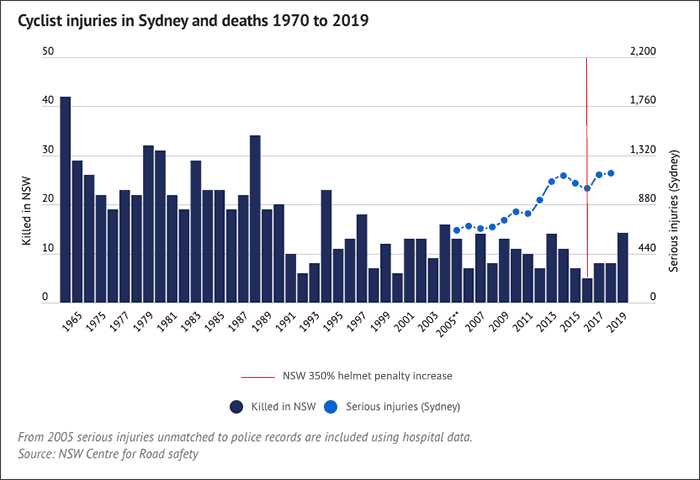In 2016 the NSW Government in Australia increased its bicycle helmet penalty to the highest in the world, but data analysis shows the hike in fines discouraged cycling participation and failed to meet its stated aim of reducing cyclist deaths and injuries.
When the NSW Government increased its bicycle helmet penalty by 350% from $71 to $319 in 2016, it claimed the move was to save lives and reduce cyclist injuries.
In early 2016, then NSW Roads Minister Duncan Gay said:
“We don’t want cyclists’ money – that is not why we increased fines for high-risk and downright stupid behaviour. These changes are about changing behaviour and improving safety. With cycling injuries remaining high in NSW, I had no choice but to look at tougher deterrents and increased enforcement to improve safety for cyclists and other road users. I hope I don’t see another dollar in fine revenue but I do hope to see a reduction in cyclist injuries.”
From 2016 to 2020, the NSW Government made more than $8 million from it’s helmet penalty increase. Known revenue from bike helmet fines in NSW are:
2014 – 5,104 fines of $346,712
2015 – 4,748 fines of $332,060
2016 – 6,337 fines of $1,768,649
2017 – 5,685 fines of $1,862,775
2018 – 6,116 fines of $2,038,062
With CPI increases, the helmet penalty for riding a bike had increased to $344 by 2019. There were 6,259 helmet penalties in the 2017/18 financial year and 6,101 in 2018/19, but the revenue raised by those fines is unknown at the time of writing.
The chart below shows annual cyclist injuries and fatalities in Sydney from 1965 to 2019.
The fatality decrease in 1991 was due to the new helmet law reducing cycling participation in NSW. For example:
Same site surveys showed 3,107 students cycling to school in 1991 and 1,173 in 1992
3,332 adult cyclists at same sites in Sydney in 1991 and 2,591 in 1993
6,788 child cyclists at school, recreation and intersection surveys in 1991 and 3,798 in 1993
See Cycling participation in New South Wales
The chart below shows total annual hospitalised NSW cyclist serious injuries (on-road and off-road) from 2005 to 2019.
The chart below compares total injuries among all road users and among cyclists from 2005 to 2019.
Injury data comparing 2012-2015 with 2016-2019
In 2016-2019 there was a 3.3% increase in total NSW cyclist road injuries (+247 injuries compared to 2012-2015), a 1.6% increase in total road cyclist head injuries (+24), an 11.7% increase in total maximum severity road cyclist injuries (+44), and a 7.7% increase in maximum severity road cyclist head injuries (+15).
Those are the damning results from a collation and comparison of cyclist road injury data at the Transport for NSW Centre for Road Safety.
The data also confirms an ongoing decline in NSW 0-16yo cycling participation, with that age group’s annual average head injuries falling 29.5% from 2005-2011 to 2012-2019 (112 > 79) but annual average total injuries falling 27.7% (498 > 360). Helmets do not prevent bicycle crash injuries other than to the head and the total injury decline points to a further participation decrease.
30-49yo total cyclist road injuries increased 53.6% from 2005-2011 to 2012-2019 (418 > 642) and 50yo+ total cyclist road injuries increased 111.1% (270 > 570).
30-49yo cyclist head injuries from road crashes increased 51.2% from 2005-2011 to 2012-2019 (80 > 121) and 50yo+ cyclist head injuries increased 144.2% (43 > 105).
The 2016 increase in bike helmet penalty resulted in more total body and head injuries to middle aged and elderly NSW cyclists.
These injury increases were despite National Cycling Participation surveys showing a reduction in NSW weekly cycling from 16.7% of the state’s population in 2015 to 12.9% in 2019 – a reduction that equates to 241,572 fewer people riding bicycles in NSW.
The table below, based on Centre for Road Safety data, shows a breakdown of age brackets for cyclists who were injured on NSW roads from 2005 to 2019.
The table below shows a breakdown of age brackets for cyclists who suffered head injuries on NSW roads from 2005 to 2019.
The table below shows a 3.3% increase in total injuries and a 1.6% increase in head injuries among NSW cyclists comparing 2012-2015 with 2016-2019.
If the 2016 penalty hike convinced large numbers of NSW cyclist to wear a helmet, which it’s claimed should reduce the risk of head injury by up to 80%, the increased protection should be reflected in the number of what the Centre for Road Safety terms “maximum severity” injuries, tabulated below for total injuries.
Below tabulates the annual number of “maximum severity” head injuries among NSW cyclists from 2005 to 2019, showing an increase from 2012-2015 to 2016-2019.
Below tabulates the head proportion of total NSW cyclist injuries from 2005 to 2019, suggesting a 0.3% decrease from 2012-2015 to 2016-2019 – albeit the 20.4% in 2016-2019 still 1.1% worse than the head injury proportion of 19.3% in 2005-2011.
Below charts all injuries and head injuries among NSW cyclists from 2011 to 2019.
If the 2016 helmet penalty increase in NSW is judged by it’s stated aim of reducing NSW cyclist deaths and injuries, it has been a failure that maintains Australia’s cycling participation discouragement and injury per cyclist increase since the introduction of mandatory bicycle helmet laws in the early 1990s.
Reproduced with permission from http://www.cycle-helmets.com/nsw-2016-fine.html












